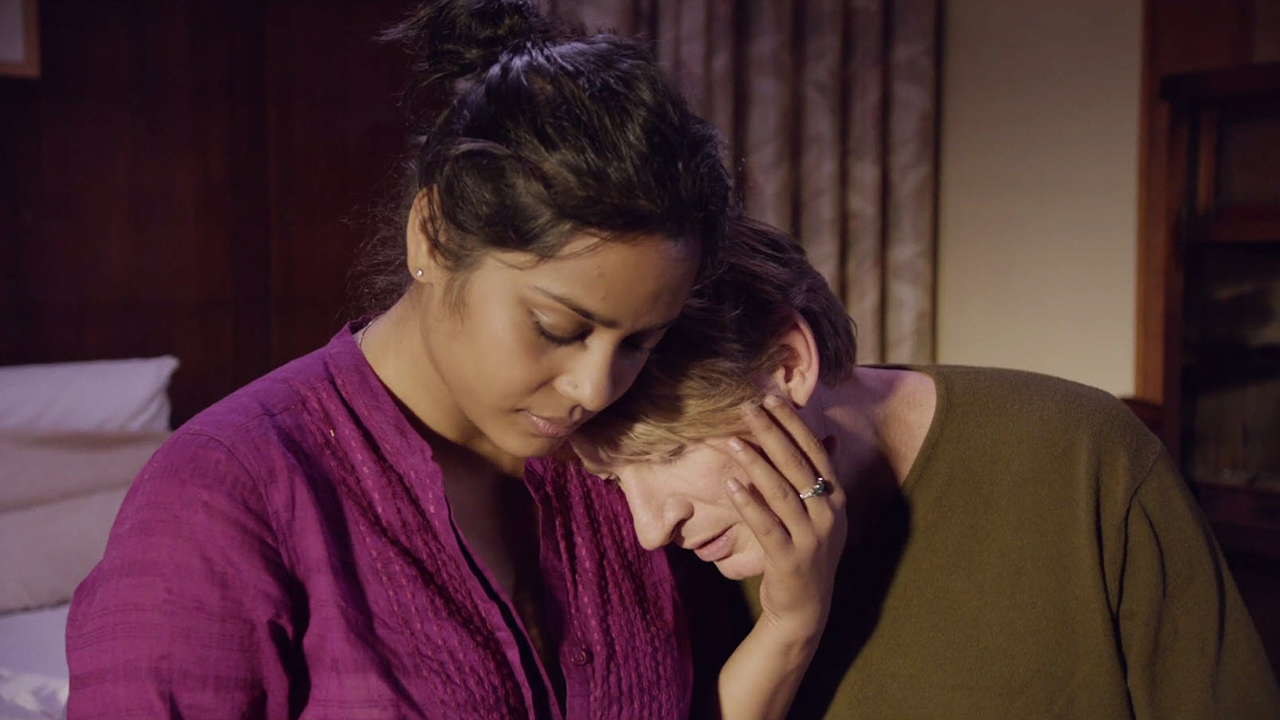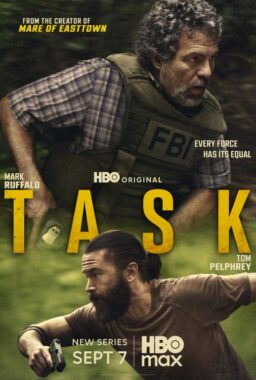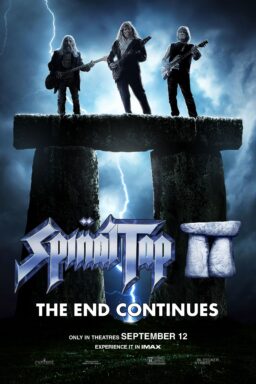To celeberate the scope of Ebertfest and the unique voices that cover it every year, we asked four different writers to cover the last day, which included screenings of “Force of Destiny,” “Radical Grace,” “Love & Mercy” and “Blow Out.”
“Force of Destiny” by Matt Fagerholm
When it rains in Paul Cox’s “Force of Destiny,” the sky remains sunny. The alleged shower is evidenced only by a thin layer of water spraying against various windows, distorting an otherwise dry and tranquil landscape. One could interpret this as a mere technical flaw, yet I suspect this recurring motif holds a deeper meaning. The film was inspired by Cox’s own battle with liver cancer and the successful liver transplant he received, as well as the romance he has found late in life. It’s clear that the filmmaker has a profound understanding of how it feels to look one’s own mortality in the face, and how illness can cloud one’s ability to embrace the beauty of a summer day. David Wenham stars as Robert, a sculptor whose cancer diagnosis occurs around the same time he falls for Maya (Shahana Goswami), a younger woman undeterred by his ailment. The appearance of renowned Indian actress Seema Biswas as Maya’s aunt hit me especially hard, since she was featured in “Patang,” a 2012 Ebertfest selection directed by Prashant Bhargava, who passed away last year. I attended my first Ebertfest in 2013 with Bhargava, and the first film I saw, oddly enough, was Cox’s 1987 masterwork, “Vincent.”
In his introduction to “Force of Destiny,” Cox referred to the film as a “spatial love story laced with a few personal experiences.” He said that “life must be an act of love—regardless of the consequences,” and he revealed that during his health struggles, Roger Ebert wrote him “the most tender and loving letter of solidarity he ever received.” Rather than close his sublimely eloquent speech by telling the audience to enjoy the movie, Cox said that he preferred films that stuck to your bones and go home with you. “When somebody makes me a cup of coffee and says, ‘Enjoy,’ I always want to give it back,” he quipped. Rosie Raka, Cox’s partner who inspired the character of Maya, joined him onstage for a post-screening Q&A moderated by Chaz Ebert and Nate Kohn. The audience rose to its feet for a standing ovation before singing “Happy Birthday” to Cox, who just happened to be celebrating his 76th birthday. Raka had also received a liver transplant, and Kohn mentioned that she had the liver of an old person, whereas Cox had the liver of a young person. “So they are roughly the same age,” Kohn concluded. The director’s face lit up when Chaz singled out a line in the film that sounded rather familiar: “Kindness covers all of my political beliefs.” It was a line taken directly from Roger, and served as the director’s tribute to one of his most devoted champions.

“Radical Grace” by Sheila O’Malley
Sister Simone, Sister Jean, Sister Chris: These are just some of the names of the group of courageous and determined nuns in Rebecca Parrish’s documentary “Radical Grace,” and they are real-life characters you will not be able to forget. The documentary charts the story of the recent censure of American nuns from the Vatican (the Bishops and Cardinals were concerned that the nuns were promoting a “feminist” agenda) and how that censure sparked a movement that continues to burgeon today. Nuns have always been at the forefront of the Church, the boots-on-the-ground element, devoted to teaching and advocacy and being of service to their communities and congregations. Nuns are often the best examples of what a “living faith” looks like. “Radical Grace,” a powerful and effective film, helmed by two women who wore many different hats, is not only a tribute to the social and political activism of these brave nuns, but a call to action for others.
As the audience drifted into the Virginia Theatre for the screening of “Radical Grace” at Ebertfest Saturday, they were greeted by the sight of a cellist onstage (Heather McIntosh, who composed the score for the film), playing one of her compositions, setting the mood for the film. The film brought laughter (the nuns are often quite funny and feisty), as well as intermittent hisses when a Bishop interviewed for the film expressed the bottom line of the all-male leadership of the Church, in terms of women’s involvement. When the film ended, there was a giant ovation. I am assuming there were many Catholics in the audience (we are everywhere), and the sight of people of faith working from within to change an age-old institution was not only heartening, but healing. Many have felt betrayed by the Church, even heartbroken. “Radical Grace” presents an alternative, an alternative that provides hope.
Chaz Ebert and Matt Fagerholm moderated the onstage discussion with director/cinematographer/editor Rebecca Parrish, producer Nicole Bernardi-Rice, composer Heather McIntosh, and Father Michael Pfleger, from St. Sabina in Chicago (a friend of Roger and Chaz Ebert).
When director Rebecca Parrish, a self-described “millennial,” interested in social justice, and founder of Interchange Productions, encountered the “nuns on the bus,” traveling around the country advocating for health care reform (often in the face of criticism from pro-life Catholics, as well as the Vatican itself), she was inspired. Parrish’s friend worked in one of the Catholic ministries that helped ex-cons to get their GEDs, and Parrish was fascinated and curious about why her “queer atheist friend” was hanging out with a bunch of nuns. Once she met some of the sisters, she understood. Parrish did not grow up in a religious tradition, although she does consider herself a “spiritual seeker,” and so she brought on producer Bernardi-Rice, who joked during the Q&A: “I’m Italian. I know about nuns.” Bernardi-Rice said that working on “Radical Grace” was a “wonderful healing experience personally,” and she expressed the views of many Catholics when she said, “I didn’t leave the Church. The Church left me.”
Parrish spoke of a moment in the film when Sister Simone collapsed in a chair after making a speech during the “nuns on the bus” tour, and murmured to a fellow nun, “Holy shit, 14 more days of this.” Parrish received some push-back on that moment, people who felt she should cut it, that it would just give ammunition to the enemies of the nuns. But Parrish fought for the moment because it showed the “human-ness” of these nuns, that they are not “above” being part of the human race. Parrish said that she found “intimacy and willingness on the part of the subjects to be vulnerable,” one of the great strengths of the film, in particular its interview segments. Heather McIntosh spoke of being inspired by the nuns in the film, these women who “put joy and energy into their passions.”
Father Pfleger’s contribution to the discussion was invaluable. He was censured in the seminary, and suspended twice. He joked, “I’m still here.” He made it a point to say, “The Church has been hijacked by a group of men,” men who value “royalty, power, dictatorship,” and observed that the Bishops and Cardinals have “created a golden calf” out of the Church itself. Pfleger said, “Social justice is the DNA of the scriptures.” For so long it has been a top-down organization, and Pfleger said, “I hope and pray we’re going to have women deacons, married priests, women priests. It’s not waiting for someone to tell us ‘It’s okay.’ It’s pushing, saying, ‘It is okay.” The new pope, Pope Francis, chose the name Francis after Saint Francis of Assisi, a 12th-century pope venerated today for his devotion to the marginalized of his time, and – sadly, still – our time: the poor, the sick and diseased—much of his work was done with lepers—and his love of the natural world and animals. Pfleger acknowledged the new feeling of freedom in the Church, because of Francis, but also sensed the political war going on in the Vatican right now, as well as strong pushback from many of the faithful. Pfleger joked, “I pray every day Francis has a food taster,” bringing waves of laughter from the audience. But, Pfleger concluded, “If Francis lives long enough to put in a new hierarchy and new thought, then there’s hope.”
Parrish has the hopes that different communities, congregations, Catholic groups will want to screen the film, and shared information on how to make inquiries. The film’s website has more information about how to host the film and how to get on their mailing list for updates on the nuns’ activities. Text the word “Radfilm” to the number “33733” and you will be put on their mailing list. The recent wave of sex abuse scandals that rocked the Church were intensely painful for Catholics, and made many Catholics question their faith, or even leave the faith. But the hope that comes from nuns, in particular, their dogged determination to be heard in a patriarchal culture, their continued advocacy for women’s deeper involvement in the church (as deacons or even priests) are living examples of practical activism geared at systemic change.
Nuns are often portrayed as comical figures in cinema, and the audience at Ebertfest often giggled at the sight of nuns trying to fix a copy machine, nuns zipping around on a motorbike. I grew up in a family with two powerhouse Great-Aunts who were radical feminist nuns, and so nuns being regular human beings was not a novelty to me. Similar to the nuns portrayed in “Radical Grace,” my aunts became nuns pre-Vatican II, watching in wonder and excitement at the daily dispatches coming from the Vatican in the 60s. During John Paul II’s 20-year “stint” as Pope, many nuns felt betrayed and hurt by the limitations placed, yet again, on their roles and participation.
I thought so much of my aunts while watching “Radical Grace.” It was a tribute to the strong women of faith in my family who refused to be silent and submissive even though they were low on the totem pole of an ancient hierarchy. There is a sense of change coming from the Vatican again, thanks to Pope Francis. The nuns in “Radical Grace” (and many Catholics around the world) considered the new pope’s name-choice to be a good omen, a message to the faithful of his attitudes towards the faith. So far those hopes have not been dashed. There is much to do, still, and much to struggle for, but “Radical Grace” shows, in no uncertain terms, that it’s finally time for that conversation. It’s time to ask those questions, to open up the conversation about the position of women in the church. It’s time to be brave. These radical nuns, and their priest allies, are showing the way.

“Love & Mercy” by Jana Monji
When the sun is out and the skies are a brilliant blue, the surf in California sings a siren song. Other places may have snow days when schools officially close due to extreme winter weather, but California coastal cities have beach days, when the call of the surf and sand cause students to skip school and adults take mental health days. “Love & Mercy” is about a man who was both part of that culture and an outsider, Brian Wilson of the Beach Boys. Fittingly, the Saturday afternoon when this film screened at Ebertfest would have been a perfect beach day, if one could have brought a beach to the Virginia Theatre in Champaign.
The title, “Love & Mercy,” comes from Brian Wilson’s 1988 debut solo album. Originally, the song was credited to Wilson, Alexandra Morgan and Wilson’s therapist, Eugene Landy. The song begins: “I was sittin’ in a crummy movie/With my hands on my chin/All the violence that occurs/Seems like we never win.”
This non-crummy movie presents us with three Brian Wilsons: The past (Paul Dano), the bed-ridden (also Dano) and the future (John Cusack). Hopping between these three different realities, in the past we follow the young Brian Wilson as he and his younger brothers Dennis (Kenny Wormald) and Carl (Brett Davern) with their cousin Mike Love (Jake Abel) and friend Al Jardine (Graham Rogers) form the Beach Boys in the landlocked city of Hawthorne, California in Los Angeles County in 1961. Dennis was the only surfer in the band, but their music embraced the surfers and beach lifestyle.
As they become more successful, they chafe under the management of their domineering father Murray Wilson (Bill Camp), and eventually sack him. Brian’s mental state also begins to disintegrate. A panic attack on an airplane leads him to quit the tour, but allows him to work full-time and over in a studio where he eventually produces the Beach Boys’ 11th studio album, “Pet Sounds.”
The future Brian meets and begins courting the woman who will become his second wife, Melinda (Elizabeth Banks). Dennis is already dead, having drowned in 1983. Carl is still alive, but we never see him in this reality (Carl died of lung cancer in 1998). Instead, we see Landy (Paul Giamatti) and his scruffy goon squad. Landy may have saved Brian from his drug-addicted bedridden present self, but only by exerting an abusively demeaning control over all aspects of Brian’s life, something that alarms Melinda.
By flitting in between the realities, director Bill Pohlad is able to juxtapose Camp’s angry Murry and Giamatti’s Landy while giving us a sense of instability with this constant shifting of timelines. During the panel discussion following the film, RogerEbert.com assistant editor Matt Fagerholm commented, “It’s like each end of his life is haunting each other” because they have similarly abusive dynamics.
Three of the “Love & Mercy” panelists—mediator Illinois film critic Chuck Koplinski, University of San Diego professor of communication Eric Pierson, and local musician and filmmaker John Isberg (Swede Films)—had been on the Thursday morning panel discussion, “Challenging Stigma Through Love, Mercy and the Arts.” Isberg, who teaches kids who have been suffered emotional abuse, commented, “The thing I love about Brian Wilson is that he’s goes through horrible times but he’s not writing angry punk songs; he’s writing ‘God Only Knows’ and ‘Love & Mercy.’” Isberg liked that Brian “gives up that space” and lets his brother Carl sing the lead on “God Only Knows” because Brian feels Carl’s got the most angelic voice he has ever heard. Only a person who really believes in music would be able to put the music before his own ego.
Pierson commented that often when portraying creative people the narrative tends to be that “his mental illness, that’s part of what made him creative,” but he feels strongly “that’s not where we need to go with that particular conversation.”
Fagerholm noted that Pohlad portrayed mental illness in a manner that wasn’t stereotypical or judgmental. He especially liked the “weird atonal” sounds in a headphone scene, taking the audience into “a David Lynchian nightmare” of distortion to show what is “going on psychologically in a way that you can’t put into words.”
After the screening, we walked out to the end of a sun-kissed day far away from any beach. Growing up in San Diego, I consider the Beach Boys the soundscape of home. Now living in Torrance, I’m just eight miles away from the California Historic Landmark for the Beach Boys childhood home (3701 W. 119th Street). Next month marks the 50th anniversary of the release of “Pet Sounds,” the Beach Boys album that in 2004, the Library of Congress preserved in the National Recording Registry. Isn’t that reason enough for a May beach day?

“Blow Out” by Peter Sobczynski
In the 35 years or so since I first saw Brian De Palma’s “Blow Out,” I have seen it countless times and in a variety of formats ranging from CED Videodisc to cable to Blu-ray and have even been lucky enough to have caught it projected in the glory of 35mm film at a couple of points along the way as well. I could not begin to tell you the number of times that I have seen it over the years but I can tell you without hesitation that none of those previous encounters could hold a candle to the presentation that it received as the final film of the last full day of screenings at this year’s Ebertfest. To see it within the confines of the Virginia Theatre, a old-fashioned movie palace that has been tricked out with ideal projection and sound systems, is a treat that serves as a reminder of how puny even the most majestic of films can seem when shown on a TV, smartphone or dumpy multiplex screen. To see it presented via a vintage 35mm print is a reminder as to how beautiful a celluloid image can look when properly projected and how much we have lost in terms of visual presentation in the shift from film to digital. Best of all, to see the film, whose box-office failure upon its original release was blamed largely on audience resistance to it dark and cynical narrative and emotional gut-punch of a finale, hold hundreds of moviegoers—ranging from longtime fans to those seeing it for the first time—absolutely spellbound from the first minute to the last was an astonishing experience that was less a night at the movies than a master class in the notion of pure cinema conducted by a maestro working at the absolute peak of his considerable powers.
Watching it again last night under such ideal circumstances, “Blow Out” only solidified its position as one of my Top 10 all-time favorite movies but I found myself picking up on certain aspects of it more strongly than I did in the past. For one thing, seeing it presented in such a beautiful manner only further served to highlight the contributions of the late cinematographer Vilmos Zsigmond, who conjured up one arresting image after another, ranging from the grandiose (such as the knockout climax involving fireworks and an enormous American flag as the background to a moment of shocking violence) to the modest but no less striking (such as a “River”-era Bruce Springsteen shirt slung over a chair in a corner that you practically want to reach out and grab for yourself). As film critic Leonard Maltin pointed out during the post-screening discussion, a film that once presented what was considered to be nearly state-of-the-art in regards of filmmaking technology now stands as a poignant reminder of the analog age of filmmaking when the recording and marrying of sound and picture was dependent not on computers but on heavy equipment that people had to run actual film and tape through back and forth in a painstaking effort to achieve the desired effect. (The scene in which John Travolta’s character creates a little movie out of sound that he recorded and a series a photographs in a magazine that proves the existence of a murder and subsequent coverup remains one of the most breathtaking in De Palma’s considerable oeuvre of cinematic set pieces.) Additionally, despite its 1981 release date, “Blow Out” plays like one of the very last films of the 1970s, an era in which one could still create and execute a complex adult drama that was’t afraid to be smart and edgy and dark.
Making the screening even more special was the post-film Q&A that Maltin conducted with co-star Nancy Allen, who plays the shopgirl/hooker who finds herself stuck in the middle of an increasingly out-of-control political conspiracy. For about 45 minutes, the two chatted about the film, which was her fourth and final collaboration with De Palma, to whom she was married at the time. (The other films they worked on together were “Carrie,” “Home Movies” and “Dressed to Kill.”) Regarding “Blow Out,” she gave insights into all aspects of the production and offered up numerous bits of trivia. The big Liberty Day parade sequence—an elaborate chase scene involving speeding jeeps, huge crowds, helicopters and the like—was actually a reshoot necessitated when the footage of the original shoot was stolen on its way to be processed and never recovered. She also revealed that the two central roles were initially written for older actors and when John Travolta expressed interest both in appearing in the film and working with Allen (whom he co-starred with in “Carrie”), the parts were rewritten to allow them to play them. While talking about the famous scream that she utters at the climax of the film, she mentioned that many of the other screams that we hear to more humorous effect throughout—there is a running joke about the producers of the sleazy slasher film that Travolta is working on as a sound man trying and failing to find the right-sounding scream for a murder scene—were delivered by her as well. Outside of her films with De Palma, she also touched on some of the other key titles in her filmography, including Robert Zemeckis’ hilarious debut “I Wanna Hold Your Hand,” Steven Spielberg’s comedy epic “1941” and Paul Verhoeven’s still-subversive action epic “Robocop.”
Then, to top everything, at the annual post-screening shindig marking the virtual end of Ebertfest, I got a chance to talk to Nancy Allen for a few minutes, and as someone who reveres films like “Blow Out,” “Carrie,” “Dressed to Kill,” “1941” and “Robocop,” you cannot begin to imagine what a thrill that was. As she was on the stage, she was gracious, funny and charming to whatever idiocies I was uttering. It was the perfect ending to what was pretty much a perfect moviegoing experience—the kind that Ebertfest has specialized in over the years and which will hopefully continue to do well into the future.











